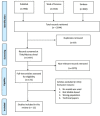Digital health interventions for chronic diseases: a scoping review of evaluation frameworks
- PMID: 32156751
- PMCID: PMC7252973
- DOI: 10.1136/bmjhci-2019-100066
Digital health interventions for chronic diseases: a scoping review of evaluation frameworks
Abstract
Background: Monitoring and evaluations of digital health (DH) solutions for the management of chronic diseases are quite heterogeneous and evidences around evaluating frameworks are inconsistent. An evidenced-based framework is needed to inform the evaluation process and rationale of such interventions. We aimed to explore the nature, extent and components of existing DH frameworks for chronic diseases.
Methods: This review was conducted based on the five steps of Arksey and O'Malley's scoping review methodology. Out of 172 studies identified from, PubMed, Embase and Web of Science, 11 met our inclusion criteria. The reviewed studies developed DH frameworks for chronic diseases and published between 2010 and 2018.
Results: According to WHO guidelines for monitoring and evaluation of DH interventions, we identified seven Conceptual frameworks, two Results frameworks, one Logical framework and one Theory of change. The frameworks developed for providing interventions such as self-management, achieving personal goals and reducing relapse for cardiovascular disease, diabetes, chronic obstructive pulmonary disease and severe mental health. A few studies reported evaluation of the frameworks using randomised clinical trials (n=3) and feasibility testing via Likert scale survey (n=2). A wide range of outcomes were reported including access to care, cost-effectiveness, behavioural outcomes, patient-provider communications, technology acceptance and user experience.
Conclusion: There is a lack of evidence on the application of consistent DH frameworks. Future research should address the use of evidence-based frameworks into the research design, monitoring and evaluation process. This review explores the nature of DH frameworks for the management of chronic diseases and provides examples to guide monitoring and evaluation of interventions.
Keywords: BMJ Health Informatics; health care; medical informatics.
© Author(s) (or their employer(s)) 2020. Re-use permitted under CC BY-NC. No commercial re-use. See rights and permissions. Published by BMJ.
Conflict of interest statement
Competing interests: None declared.
Figures
References
-
- World Health Organization Global diffusion of eHealth: making universal health coverage achievable: report of the third global survey on eHealth. In.: World Health Organization, 2016.
Publication types
MeSH terms
LinkOut - more resources
Full Text Sources
Medical
Miscellaneous



